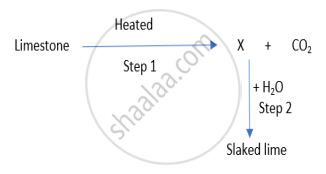Advertisements
Advertisements
प्रश्न
Explain the following reaction with their balanced chemical equation.
Ammonia gas reacts with hydrogen chloride.
उत्तर
Ammonia gas and hydrogen chloride gas react to form the salt ammonium chloride. It is a combination reaction.
\[\ce{\underset{\text{Ammonia}}{NH_{3(g)}} + \underset{\text{Hydrogen chloride}}{HCl_{(g)}} -> \underset{\text{Ammonium chloride}}{NH4Cl_{(s)}}}\]
संबंधित प्रश्न
Write the balanced chemical equation for the following and identify the type of reaction.
\[\ce{Hydrogen(g) + Chlorine(g) -> Hydrogen chloride (g)}\]
Why is respiration considered an exothermic reaction? Explain.
What happens chemically when quicklime is added to water filled in a bucket?
What type of chemical reaction is represented by the following equation?
A + B → C
What type of reaction is represented by the following equation?
CaO + CO2 → CaCO3
Give one example of a combination reaction which is also endothermic.
What happens during a chemical reaction ?
What do you observe when solid lead nitrate is heated?
What do you observe when when dilute sulphuric acid is added to barium chloride solution ?
Fill in the blank
A reaction in which two or more substances combine to form a single substance is called a ............ reaction.
Fill in the blank
The chemical reaction between hydrogen and chlorine is a ................ reaction
Classify the following reaction as combination, decomposition, displacement, precipitation and neutralization. Also balance the equation.
\[\ce{CaCO3_{(s)} ->[heat]CaO_{(s)} + CO2_{(g)}}\]
What are chemical combination or synthesis reactions ? Chemical combination or synthesis:
A student prepared an aqueous solution of CuSO4 in beaker X and an aqueous solution of FeSO4 in beaker Y. He then dropped some iron pieces in beaker X and some zinc pieces in beaker Y. After about 10 hours he observed that the solutions in X and Y respectively appear:
(A) blue and green
(B) colourless and pale green
(C) colourless and light blue
(D) greenish and colourless
(a) What is double displacement reaction? Explain with an example.
(b) A small amount of quick lime is added to water in a beaker.
(i) Name and define the type of reaction that has taken place.
(ii) Write balanced chemical equation for the above reaction and the chemical name of the product formed.
(iii) List two main observations of this reaction.
Define: Chemical combination reaction
Give a balanced equation for –
A direct combination reaction involving two elements, one of which is a non-metal
Complete the statement by filling in the blank with the correct word:
Direct combination reaction of phosphorus pentoxide with water gives _______.
H2(g) + Cl29(g) → 2HCl(g) is a ______
The number of products formed in a synthesis reaction is ______
Define a combination reaction. Give one example of an exothermic combination reaction.
In which of the following chemical equations, the abbreviations represent the correct states of the reactants and products involved at reaction temperature?

Identify the correct option from the given table which represents the type of reactions occurring in step 1 and step 2.
Balance the following chemical equation and identify the type of chemical reaction.
`"Mg"("s") + "Cl"_2("g") -> "MgCl"_2("s")`
Balance the following chemical equation and identify the type of chemical reaction.
`"Na"("s") + "S"("s") overset("(Fuse)")(->) "Na"_2"S"("s")`
Give the chemical reaction when a few pieces of slaked lime are added to a beaker half-filled with water. Will it be an endothermic or exothermic reaction?
Read the text below and answer the questions that follow:
A small amount of hydrochloric acid was taken in a test tube. The test tube was heated. A glass rod was dipped in the ammonia solution and held on the top of the test tube. A white smoke was seen emanating from the tip of the glass rod.
- What must have happened?
- Which colour of gas is formed?
- Write the chemical equation for the reaction.
A clear solution of slaked lime is made by dissolving Ca(OH)2 in an excess of water. This solution is left exposed to air. The solution slowly goes milky as a faint white precipitate forms. Explain why a faint white precipitate forms, support your response with the help of a chemical equation.
A metal ribbon 'X' bums in oxygen with a dazzling white flame forming a white ash 'Y'. The correct description of X, Y and the type of reaction is:
- Assertion: Rusting of Iron is endothermic in nature.
- Reason: As the reaction is slow, the release of heat is barely evident.
